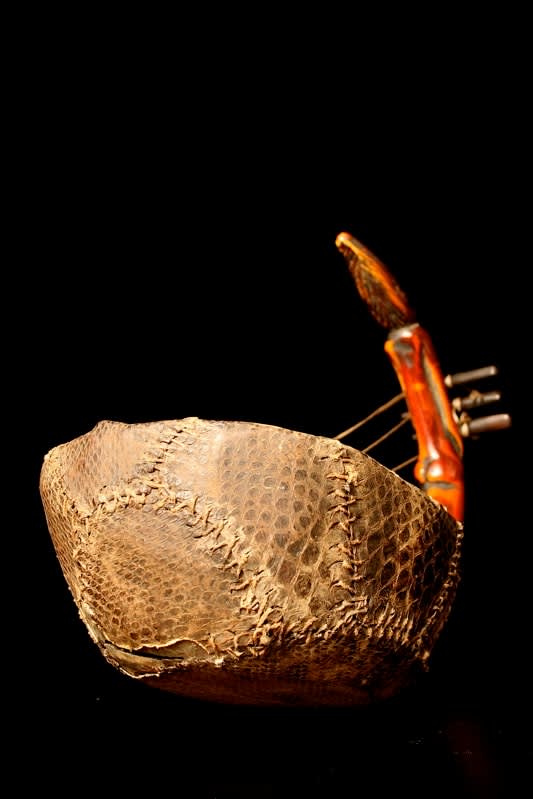Mangbetu Musical Instrument, 20th Century CE
Skin, Ivory
15.75
DA.691 (LSO)
This remarkable piece is a harp made by the Mangbetu people of what was once Zaire. It is a probably wood solid frame, covered in reptile leather stretched tight across...
This remarkable piece is a harp made by the Mangbetu people of what was once Zaire. It is a probably wood solid frame, covered in reptile leather stretched tight across it and bound with twine and leather thongs. There are three strings attached to a central sound board beneath the leather, and two sound holes. The strings are tied taut to the neck of the piece, which arches away and upwards from the main body of the instrument. It is remarkable for being partly made of ivory, a section of which has been sculpted into the likeness of a woman with and arched back and her arms by her sides, facing away from the instrument and the pegs piercing her abdomen (there is a fourth, empty, string hole). Her hair is drawn back into a cap which is more reminiscent of Kongo or Yoruba pieces. The patination of the handle is superb, and would seem to indicate that it is either from another piece originally or that the skin on the instrument has been replaced.
The Mangbetu moved to the Congo region from Sudan in the 1700s, and live in societies that revolve around a court system. They are particularly renowned for their professional musicians, and also for their extravagant dancing and ceremonial pageantry. Their artworks were produced for the royal court families, and ranged from architecture to objects of religious/spiritual significance and secular items decorated with pleasing motifs and designs.
Mangbetu art is perhaps most recognizable for the inverted-cone coiffures of the (usually female) figures that tend to adorn it. This is seen in the rare wooden figures, as well as in ceramics. The coiffure – exaggerated by cranial deformation during infancy – was worn by women until the 1950s. Most of the pieces found their way to the royal courts. Kings were originally believed to be semi-divine, able to control natural resources using magical objects such as leopard parts. In the 1850s they were credited with possessing a force called nebeli, which was used to lure animals into traps and also to deceive colonial enemies. Their resistance to European rule had serious socioeconomic repercussions, but by the time that the European hold on the area had solidified, the Mangbetu were in the habit of trading and exchanging prestige goods – possibly including pieces such as this – between chiefly courts and to colonials.
There is unlikely to be any other role than a decorative one in the current piece. The Mangbetu creator god is named Noro (also Kilima), but there is little sculptural abstraction in Mangbetu art that hints at an aim beyond the representational, or the secular decorative. The personages may represent ancestors, which the kings usually command be revered. It is possible that the decorations on such pieces are designed to repel the negative effects of ‘Likundu’ – evil spirits – or witchery, which is a major concern in Mangbetu society.
This is an attractive and moving piece of Mangbetu art.
The Mangbetu moved to the Congo region from Sudan in the 1700s, and live in societies that revolve around a court system. They are particularly renowned for their professional musicians, and also for their extravagant dancing and ceremonial pageantry. Their artworks were produced for the royal court families, and ranged from architecture to objects of religious/spiritual significance and secular items decorated with pleasing motifs and designs.
Mangbetu art is perhaps most recognizable for the inverted-cone coiffures of the (usually female) figures that tend to adorn it. This is seen in the rare wooden figures, as well as in ceramics. The coiffure – exaggerated by cranial deformation during infancy – was worn by women until the 1950s. Most of the pieces found their way to the royal courts. Kings were originally believed to be semi-divine, able to control natural resources using magical objects such as leopard parts. In the 1850s they were credited with possessing a force called nebeli, which was used to lure animals into traps and also to deceive colonial enemies. Their resistance to European rule had serious socioeconomic repercussions, but by the time that the European hold on the area had solidified, the Mangbetu were in the habit of trading and exchanging prestige goods – possibly including pieces such as this – between chiefly courts and to colonials.
There is unlikely to be any other role than a decorative one in the current piece. The Mangbetu creator god is named Noro (also Kilima), but there is little sculptural abstraction in Mangbetu art that hints at an aim beyond the representational, or the secular decorative. The personages may represent ancestors, which the kings usually command be revered. It is possible that the decorations on such pieces are designed to repel the negative effects of ‘Likundu’ – evil spirits – or witchery, which is a major concern in Mangbetu society.
This is an attractive and moving piece of Mangbetu art.
1
of
860
